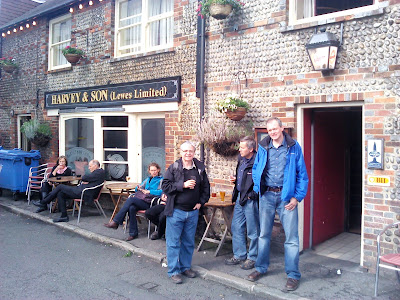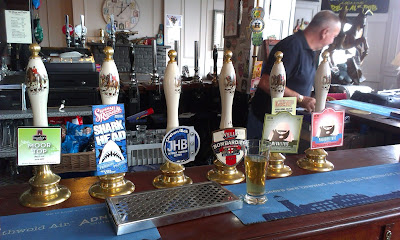Thursday evening, in what was a first for me, I visited a
“Hungry Horse”. The latter is a nationwide chain of 225 pub-restaurants, owned
by Greene King of Bury St Edmunds. It was founded in 1995, and promotes itself
as offering low cost meals for families and groups.
There are only a handful of Hungry Horse establishments in
Kent, but the nearest is now only around 15 minutes drive away, thanks to the
completion recently of the road improvements to the A21 between Tonbridge and
Pembury.
The Hungry Horse pub in question is the Robin Hood, a large
estate pub to the east of Tunbridge Wells town centre, and the other side of
the rail tracks from the suburb known as High Brooms. It is a former Whitbread
pub which was quite well known to me during the later 1980’s, when I worked on
the nearby North Farm Estate.
The pub was built at the end of the Edwardian era and
started life as a private residence. It became a public house in 1971, and was
named the Robin Hood because of its proximity to the Sherwood housing estate. The
latter estate has had a bad reputation amongst Tunbridge Wells residents over
the years; somewhat unfairly in my book, but I suppose every town has its less
salubrious side, which locals will look down their noses at.
After Whitbread stopped being a brewer and started running coffee shops instead, the Robin Hood
passed into the hands of Enterprise Inns, and in 2007 a major refurbishment of
the premises was carried out. It was all the more surprising then when, just
six years later, Enterprise closed
the pub and put it up for sale. This was where Greene King stepped in and
rescued the pub, converting it into a Hungry Horse in the process.
Back in the late summer of 2013, I wrote about how another
nearby pub had been given a new lease of life after somewhat ironically being
closed by Greene King. At the end of my article about the Brick Works pub in High
Brooms, I hinted that another local pub was due to re-open, but this time GK
were the saviour, rather than the villain.
I deliberately didn’t name the pub, as I said I wanted to
visit the place first, and see the developments and changes for myself, before
writing about them, and also revealing the pub which was, of course, the Robin Hood.
Little did I think it would be over four years until I managed a visit.
That opportunity came on Thursday evening, when my son and I
were over at the North Farm Retail Park. After spending rather a long time in
PC World, looking at new laptops, we were both feeling hungry and keen to find
somewhere to eat. Matthew had over-dosed rather on MacDonald’s during the week,
and didn’t fancy a KFC either. It was his suggestion to try the Hungry Horse
a.k.a. the Robin Hood.
The car park seemed pretty full when we arrived, but we
managed to find a space in the over-flow area. We entered towards the rear of
the pub, close to the section which formerly housed the function room. It
seemed strange stepping back inside after a gap of almost 25 years, but I was
pleasantly surprised by what I saw.
The former high ceiling had been replaced by a lower, false
one, and the open plan layout had been divided up into a several separate
areas, creating a much more comfortable and cosy feel to the place. As both of
us were strangers to the Hungry Horse concept, we took a little time perusing
the menu, but soon realised that the offering was quite similar to
Wetherspoon’s.
There are deals available which are day specific ( “Big
Plate Specials” on Tuesday Curry on Wednesday, free dessert on Thursday). The
option we selected was the burger one, which is available Monday to Friday and
allows customers to add a drink to any burger selection for just £1. The choice
was little limited of course, I had a pint of GK IPA, whilst Matthew chose a
pint of Carlsberg.
As with Spoons, we ordered at the bar, both choosing the
“Pit Burger” option (a beef burger topped with smoked streaky bacon, cheese and
slow cooked BBQ pulled pork rib meat). The
food arrived quickly, was piping hot and nicely presented; although Matthew
wasn’t keen on the chips being stuffed into a small metal bucket. For the
princely sum of just under £9 each, it was a good deal all round.
The pub was less busier than the car park suggested,
although its Tardis-like interior seemed capable of accommodating lots of
people without appearing over-crowded. We were both pleasantly surprised, and
whilst my pint of IPA wasn’t exactly over-flowing with character, it was still
well-kept and in good condition.
The verdict is that we will definitely return, and next time
bring Mrs PBT’s along with us. She was out with a group of her girly mates that
evening, trying out the Rose Revived, a lovely old pub on the edge of Hadlow
which has recently received a full re-vamp and revert to its original name.
I collected her and a couple of her friends just before closing time, so was able to see for myself the work that had been done.
The Rose looks well worthy of a return visit and Eileen and her friends were
singing the praises of the food there as well.
So with a budget price “fill your boots” establishment and a
tastefully renovated 400 year old inn for the Bailey family to visit, what's
not to like?






































